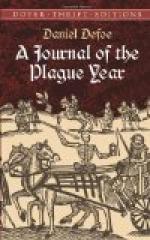The pain of the swelling was in particular very violent, and to some intolerable; the physicians and surgeons may be said to have tortured many poor creatures even to death. The swellings in some grew hard, and they applied violent drawing-plaisters or poultices to break them, and if these did not do they cut and scarified them in a terrible manner. In some those swellings were made hard partly by the force of the distemper and partly by their being too violently drawn, and were so hard that no instrument could cut them, and then they burnt them with caustics, so that many died raving mad with the torment, and some in the very operation. In these distresses, some, for want of help to hold them down in their beds, or to look to them, laid hands upon themselves as above. Some broke out into the streets, perhaps naked, and would run directly down to the river if they were not stopped by the watchman or other officers, and plunge themselves into the water wherever they found it.
It often pierced my very soul to hear the groans and cries of those who were thus tormented, but of the two this was counted the most promising particular in the whole infection, for if these swellings could be brought to a head, and to break and run, or, as the surgeons call it, to digest, the patient generally recovered; whereas those who, like the gentlewoman’s daughter, were struck with death at the beginning, and had the tokens come out upon them, often went about indifferent easy till a little before they died, and some till the moment they dropped down, as in apoplexies and epilepsies is often the case. Such would be taken suddenly very sick, and would run to a bench or bulk, or any convenient place that offered itself, or to their own houses if possible, as I mentioned before, and there sit down, grow faint, and die. This kind of dying was much the same as it was with those who die of common mortifications, who die swooning, and, as it were, go away in a dream. Such as died thus had very little notice of their being infected at all till the gangrene was spread through their whole body; nor could physicians themselves know certainly how it was with them till they opened their breasts or other parts of their body and saw the tokens.
We had at this time a great many frightful stories told us of nurses and watchmen who looked after the dying people; that is to say, hired nurses who attended infected people, using them barbarously, starving them, smothering them, or by other wicked means hastening their end, that is to say, murdering of them; and watchmen, being set to guard houses that were shut up when there has been but one person left, and perhaps that one lying sick, that they have broke in and murdered that body, and immediately thrown them out into the dead-cart! And so they have gone scarce cold to the grave.




